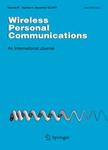版权所有:内蒙古大学图书馆 技术提供:维普资讯• 智图
内蒙古自治区呼和浩特市赛罕区大学西街235号 邮编: 010021

作者机构:Nera Res N-1375 Billingstad Norway Chalmers Univ Technol Dept Signals & Syst Commun Syst Grp SE-41296 Gothenburg Sweden
出 版 物:《WIRELESS PERSONAL COMMUNICATIONS》 (无线个人通信)
年 卷 期:2002年第20卷第1期
页 面:61-74页
核心收录:
学科分类:0810[工学-信息与通信工程] 0809[工学-电子科学与技术(可授工学、理学学位)] 08[工学]
主 题:sequential decoding Rayleigh fading Fano algorithm Pareto exponent wireless communication quantization
摘 要:The performance of sequential decoding of long constraint length convolutional codes is evaluated for Rayleigh fading channels. Sequential decoding is not practical below a certain theoretical signal-to-noise ratio, and these theoretical limits are calculated for a number of modulation methods and code rates. As an example, with BPSK modulation, soft decisions and code rate 1/2, the theoretical signal-to-noise ratio per information bit is 5.7 dB. Above this limit the bit error rate can be made arbitrarily small by increasing the constraint length at no significant complexity cost. Furthermore, it is shown that with carefully chosen quantization steps, 8 level uniform quantization gives a negligible loss also for sequential decoding on a Rayleigh fading channel. Simulation results using 8 level quantization correspond well with the theoretical performance bounds. Also, the performance on a correlated channel with finite interleaving has been obtained. With an interleaver depth of 50 x 50 and a normalized doppler frequency equal to 0.01 we are only 0.5 dB away from the performance with perfect interleaving. Finally, bit error rate results show this scheme to compete well with Turbo codes.